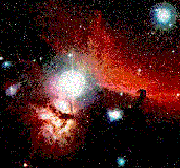








A review article written by David Bradley Science Writer for EPSRC newsletter "Newsline". Copyright David Bradley 1998. Reproduced here with permission.
Space is a messy place not least because of all the broken down satellites, chunks of rock and UFOs, but it is thick with dust as well. With support provided by the first ever joint grant from EPSRC and PPARC, New Zealand educated Professor David E Williams of the Chemistry department at University College London has begun to study the chemical reactions taking place on the surface of the dust particles, which could help clear up theories about why some molecules in space, such as hydrogen and water, are as common as they are.
Williams and his colleagues have designed a new experiment that can look at the energy of certain so-called recombination reactions in which atoms join back together to form simple, small molecules such as dihydrogen (H2), water (H2O) and carbon monoxide (CO). But how can such small molecules be relevant on a universal scale? Williams explained to Newsline:
"The main reaction is the combination of two hydrogen atoms to form a hydrogen molecule. However, when chemists work out the expected rate of this reaction in the gas phase in outer space, the result is much too low to account for the actual amounts of hydrogen present in the universe".
To explain this seeming paradox astronomers such as David A Williams and Jonathan Rawlings at UCL have postulated that any hydrogen molecules that are split apart by ultra-violet starlight must recombine on the surface of cosmic dust in a highly efficient catalytic reaction. Chemist Williams points out that the astronomers have no data on which to base their postulate, which is where his research comes in.
"The idea appears reasonable, based on back-of-envelope calculations," he says, "but the astronomers would like a firmer foundation than this."
Williams' colleague Richard Jackman in Electrical Engineering is creating forms of carbon known as diamond-like carbon. These materials are not quite as hard or crystalline as true diamond but importantly have very similar properties to the surface of cosmic dust particles in terms of their spectrum. These materials will be used as a mock cosmic particles. Williams says that once they have the cosmic dust mimic, he and his colleagues will be able to carry out some fundamental experiments using very cold hydrogen atoms to see if they can reproduce the cosmic reactions of hydrogen in the laboratory.
The researchers can cool a beam of hydrogen atoms using a helium cryostat to just 10 degrees above absolute zero. The beam is then directed towards the carbon surface held at (10-100 K) on to which other hydrogen atoms have already been adsorbed. Williams anticipates that the only product of this reaction will be dihydrogen formed as two hydrogen atoms combine in the collisions.
To confirm what is formed in the experiment he and his colleagues Stephen Price, Nigel Mason, Jon Gingell and postgraduate student James Perry will use a relatively simple but highly sensitive analytical technique known as time-gated time-of-flight mass spectrometry coupled with resonant-enhanced multiphoton ionization. A tuneable laser is used to selectively ionize H2 molecules which desorb from the 'dust' surface. These ionized molecules are then detected and identified by the mass spectrometer. The power of the technique is that due to the selectivity of the laser ionization, only molecules in certain internal states will be ionized. Hence, this simple ionization and detection scheme allows identification of the internal states and kinetic energy of the desorbed H2 molecules.
UCL theorists David Clary and Andrew Fisher, with research student Adam Farebrother, are concurrently applying a quantum scattering theory which they have newly developed , to calculate the course of the reaction.
"The calculations will give predictions of the reaction efficiency and vibrational energy distribution of the product," explains Williams, "we will compare the results to the experiment and assess which of the two possible mechanisms (Eley-Rideal or Langmuir-Hinshelwood) is the best."
He adds that once this comparison is made, if they are happy with the theory then they can use it to extrapolate from the lab into outer space.
Aside from the hydrogen recombination reaction, there are several others such as the combination of oxygen and hydrogen atoms to form hydroxyl (OH) and then water molecules.
"There appears to be a lot of water 'up there' and lots of other compounds too," explains Williams.
He and his colleagues will then progress from hydrogen to these other reactions.
The reaction sequences are purely speculation at the moment but Williams' research will hopefully give a true understanding of molecule formation in deep space, and allow some of inner most secrets of the cosmos to be unravelled.